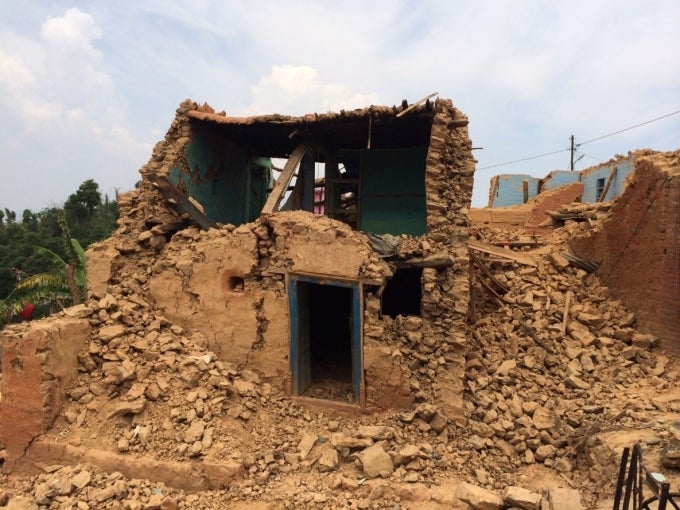
In Nepal’s hamlets and villages, in the first days following the 7.8 magnitude earthquake on April 25, families sheltered under crude lean-tos, made of whatever relatively waterproof materials they had to hand.
Keshav and his family
Keshav Thapa Magar, who lives with his wife, son and two daughters on the southeastern edge of the Kathmandu valley in Kot Gaon, had a typical earthquake experience for families of his 100-household village. The village consists in Newars, Magars, Chhetris and Tamangs, who mostly lived in traditional mud-brick or mud-stone houses before the earthquake destroyed them. Keshav’s own house, his cousin’s (like his, a traditional house) and his mother’s concrete post-and-beam house were all destroyed on April 25.

Within hours of that first earthquake, knowing that they would need shelter immediately from the unseasonably cold and rainy weather, Keshav and his son moved what valuables they could salvage into a small bamboo-framed plastic-covered greenhouse that stood near his ruined house. This structure, with their bedding laid out on the dirt floor, served as his family’s shelter for the first week or so. His mother, Kaili, 60 years-old, received a small tent for herself from her church (she is Christian, her son Hindu), where she slept with her grand-daughters.
Over the following week, Keshav and his family were able to retrieve some of the furniture from their rubbled houses, and they had chairs, bedsteads and a wardrobe in their shelter. They no longer slept on the dirt. At the same time, they began building a new shelter on a small corn field next to the greenhouse: this new structure, made with timbers and galvanized corrugated iron sheets (GCI) that they recycled from the ruins of their house, would be home during the monsoon, now just a few weeks away.
At the same time, Keshav and his son, the eldest, kept at the long hard work of pulling down their house and Kaili’s house, separating the rubble into reusable stone and brick, timbers, door frames, window frames, and other salvageables. Unrecyclable wood was stacked for firewood for the cold winter. Unusable stone was piled for later disposal, or strewn along the dirt street.
Keshav shared in this arduous task after work and on the weekends—because he had returned to his job as a driver a few days after April 25. There is no government safety net to help his family, so he has no choice but to get back to work as quickly as possible.

While many families in Nepal’s earthquake-affected districts have made progress similar to Keshav’s family, some are far behind. They are inevitably the poorest families, the elderly, families who lost their breadwinner in the earthquakes, who have many young children to feed or who have other issues. They do not have GCI sheets to recycle, or money to buy new ones—and with demand for timbers, bamboo poles and GCI sheets sharply higher, as everyone tries to rebuild before the monsoons, the prices are sharply higher too.
In rural Nepal, which has known self-reliance for centuries, everyone pitches in to help. The village drunk in Kot Gaon has not been able to help himself after the earthquake, but his neighbors—despite their own difficulties—are providing support.
With the emergency rescue and relief operations winding down over the next weeks, the government and its development partners are now starting to look into rehabilitation and reconstruction. This is where the World Bank has been active.
What the Bank is doing on the ground
Staff from Bank offices around the world were mobilized within days of the first earthquake to begin thinking through the activities and modalities that would enable Nepalis who suffered the most from the earthquake to resume their lives as quickly as possible.
Bank staff, in partnership with the EU and the UN, are leading a post-earthquake damages and needs assessment. A team is advising the government on conducting a comprehensive review of the structural integrity and reparability of buildings damaged in the earthquakes. Another team is preparing a budget support operation to help the government to finance immediate needs, building on a financial sector development policy credit that was almost ready to go to the Board for consideration when the first earthquake struck. Sectoral teams are also reviewing projects in our ongoing portfolio to see how already-committed funds can be reallocated to address emergency conditions: in fact, a roads mission that had arrived in Kathmandu just before the earthquake stayed in Nepal to work with the roads authorities to ensure that transport bottlenecks were addressed as quickly as possible in the crucial early days of the relief and recovery effort.
Bank staff are also working hard to help the government and its development partners address the most difficult immediate challenge emerging from the earthquake emergency, namely, helping the rural poor to get through the upcoming monsoon and winter, to rebuild their houses (to a higher earthquake-resilient standard) and to resume their agricultural activities. Many rural households will need small cash transfers for six to twelve months to keep them afloat as well as to help them to acquire the inputs needed to rebuild their houses. Determining who the beneficiaries should be, in thousands of small villages strewn along remote mountain slopes, and what system will work best to transfer cash and knowledge to them in a timely and reliable manner is not easy.
With extensive experience from earthquakes in Haiti, India, Pakistan and Turkey—among other places—the Bank is in a good position to help.


Join the Conversation